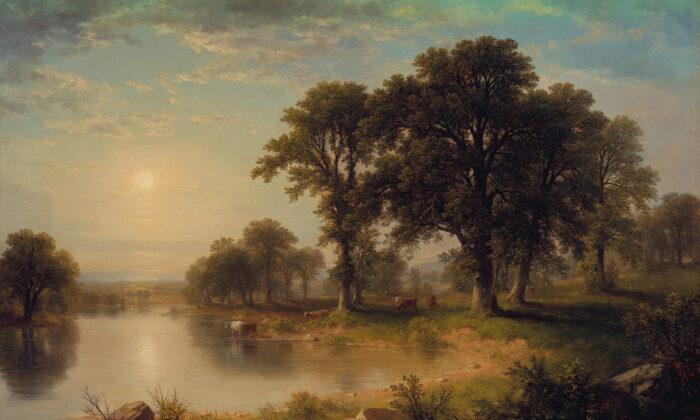From generals to lieutenants, the best military commanders study the lay of the land and the weather ahead of any mission. How steep are the hills? Are the valleys bare of vegetation or thick with vines and trees? What’s the heat index? Is rain likely? Failure to account for these factors can lead to defeat before the battle has commenced.
Like these warriors, poets often consider terrain and climate when marshalling their words, using for their verse an environment with which they are familiar and which best fits the mood and intention of the poem. This common-sense practice can make for great poetry, but it may require some extra imagination depending on where the reader lives.
Here’s an example: A young man who makes his home in Minneapolis memorizes Shakespeare’s famous Sonnet 18, which begins, “Shall I compare thee to a summer’s day?” That evening, he recites it to his fiancée, who smiles and says, “That’s so sweet.” Meanwhile, in Miami, another man declaims this same verse to his bride-to-be. “Summer?” she says, ribbing him. “So, what’s that make me? Hurricane season, temps in the 90s, and dive-bomber mosquitoes?” To put it another way, some of Robert Frost’s New England poems may seem as foreign as a snowman to a kid living in the Mississippi Delta.
The Bounties of Mother Nature

Meantime his golden face around He bares to all the garden ground, And sheds a warm and glittering look Among the ivy’s inmost nook.
Above the hills, along the blue, Round the bright air with footing true, To please the child, to paint the rose, The gardener of the World, he goes.
In Shakespeare’s “A Midsummer Night’s Dream,” it is a fairy who brings the raiment of summer to the woodland and who answers Puck’s question, “How now, spirit? Whither wander thou?” with a song fixed on the natural world:And I serve the Fairy Queen, To dew her orbs upon the green. The cowslips tall her pensioners be; In their gold coats spots you see, Those be rubies, fairy favors, In those freckles live their savors: I must go seek some dewdrops here, And hang a pearl in every cowslip’s ear.

The katydids and stridulant cicadas Regale us with their aestival sonatas.
At night, surrounded by the song of crickets, We listen just as though we’d paid for tickets.
Of course, not everyone takes pleasure in this orchestra, and surely no one is a fan of mosquitoes. Mossie is Australian slang for mosquito, and in her humorous “Mossie Malice” Susan Jarvis Bryant, a Brit now living in Texas, strikes a blow against these summer pests:Now, swat in hand, I plot to kill such irksome quirks of Earth’s ill will . . . I’ll swish and squish and smash and smite until those suckers cannot bite!
The Children of Summer

Like Anderson’s concertgoers, we engage with the slower pace of summer, but surely none do so more than children. The routine of classes is gone, the textbooks and backpacks are put aside, and the days are bright with liberty and adventure. The children live the dreams of summer, but the poets help the rest of us to remember them.
The sun is rich And gladly pays In golden hours, Silver days,
And long green weeks That never end. School’s out. The time Is ours to spend.
There’s Little League, Hopscotch, the creek, And, after supper, Hide-and-seek.
The live-long light Is like a dream, And freckles come Like flies to cream.

And does it not seem hard to you, When all the sky is clear and blue, And I should like so much to play, To have to go to bed by day?
For many young people, the community pool is central to summer. Here, friends gather, boys and girls flirt, and mothers dip their infants in the wading pool. In “The Summer I Was Sixteen,” Geraldine Connolly’s imagery will awake in adults memories of those afternoons they spent poolside as teens. The poem begins,The turquoise pool rose up to meet us, its slide a silver afterthought down which we plunged, screaming, into a mirage of bubbles. We did not exist beyond the gaze of a boy.
Later, Connolly mentions dancing to “Duke of Earl,” which would set the scene in the mid-1960s, and the rest of the poem is filled with snapshots bringing back those days: “cotton candy torches, sweet as furtive kisses,” “pressed radios to our ears,” and a place “where bees staggered/ into root beer cups and drowned.”Love and Death

In our minds, and in the minds of poets, certain seasons connote big-picture ideas and emotions. Spring, for instance, that season in mythology when the goddess Ceres visits the earth to strew blossoms and buds across the land, is the time when for poets “a young man’s fancy turns to love.” In winter, Ceres returns to the underworld, and the flowers and green grasses wither away—a season we tend to associate with death. Autumn can represent both the fruition of the harvest and the twilight years of one’s life.
As for summer, perhaps it represents fullness of that life, both for poets and for us. But of course, the poetry of this season may still address the basic themes of existence. Unlike Ceres, Eros (the god of love) and Thanatos (the god of death) were never banished from the earth.
In the summer I stretch out on the shore And think of you Had I told the sea What I felt for you, It would have left its shores, Its shells, Its fish, And followed me.

Warm summer sun Shine kindly here, Warm southern wind Blow softly here. Green sod above Lie light, lie light — Good night, dear heart, Good night, good night.
This one requires a note: Though a couple of online commentators believe this verse to be some deep reflection on aging and life, it struck me as an elegy, perhaps written for his beloved daughter after her death. I was partially correct. This elegiac verse is carved on Susy’s tombstone, but Twain adapted the words from a poem by Robert Richardson. Later, he added Richardson’s name to the stone.Heart-to-Heart Magic

Pleasure can be ours from reading these poems (and for that matter, any worthy verse), but along with that pleasure comes a dialogue between the poet’s words and our own experience. This exchange goes back and forth, from what we have read in the poem to what we have seen and done, with each enhancing the other.
On some soft night in June, for instance, we listen to music of the crickets and think of Anderson’s salute to their concert, or we read the poem and recollect another night in June, perhaps decades in the past. We watch our grandchildren catching lightning bugs at twilight and think of Updike’s “June,” or we read the poem and remember when we, too, played hide-and-seek or had games of backyard catch in childhood summers.
It’s a dialogue that ends in enchantment.






